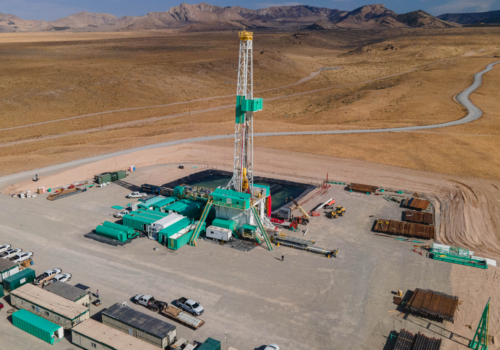To build tomorrow’s power grid, the United States should look to geothermal energy
The rapid expansion of artificial intelligence (AI) and the surge in cloud-based data centers are creating an urgent need for proportional growth in electricity.
Total US data center energy use is estimated to reach 325 to 580 terawatt-hours, or 6.7 to 12 percent of the total US energy demand, by 2028. To date, much of the supply has been sourced from traditional, carbon-heavy sources like coal and natural gas.
However, meeting the additional electricity demand while ensuring that energy grids are resilient and sustainable in the long term will require diversifying energy sources. Geothermal energy offers a promising solution for stable, reliable baseload power. But to unlock its full potential, the US government must take action to reduce the barriers to entry for industry.
Unearthed potential
Geothermal energy has numerous advantages over other renewable sources. Most immediately, it is a reliable, constant source of power as it relies on heat sources unaffected by atmospheric changes. In addition, it has a limited land footprint (per unit of power generated), minimal workforce requirements, and flexible generating capacity. Geothermal’s advantages make it an ideal complement to intermittent sources of energy such as solar and wind. With its load-following capacity—the ability to adjust power output depending on demand—geothermal can stabilize the grid, ensuring continuous power. Its resilience to weather-related disruptions, due to being located underground, further strengthens its role in maintaining grid stability amid climate volatility.
Despite providing reliable power generation for over a century, geothermal sources currently account for just 0.4 percent of US electricity generation. Naturally occurring or conventional geothermal systems are geographically limited, primarily found in the western United States. But next-generation emerging technologies may enable access to new sources in other locations. Conventional geothermal systems rely on heat sources, water, and natural fractures. But next-generation technologies, such as enhanced geothermal systems and closed-loop systems, use engineered fractures or closed wellbore loops to circulate fluids for energy capture where fractures do not naturally exist. These innovative approaches can unlock up to ninety gigawatts of clean, reliable power by 2050, dramatically expanding geothermal energy’s role in the US power grid.
Incremental advancements have also enhanced the efficiency of current geothermal technologies. For instance, drilling speeds at the US Department of Energy’s Frontier Observatory for Research in Geothermal Energy (FORGE) site have improved by over 500 percent in just three years, substantially cutting well-development costs. Such advancements bring geothermal closer to being cost competitive, with future projects potentially lowering operating costs by 17 to 30 percent by 2030.
Widely supported
Geothermal technology currently enjoys bipartisan Congressional support. The House of Representatives passed HR 6474, a bill that would amend the Energy Policy Act of 2005 to speed up geothermal development by offering categorical exclusions for environmental reviews in areas with prior drilling. The bipartisan bill—sponsored by US representatives Michelle Steele (R-CA) and Susie Lee (D-NV)—has been referred to the Senate Committee on Energy and Natural Resources.
Another bill that has been introduced in support of geothermal development is the HEATS Act, which would exempt certain geothermal activities on state and private lands (excluding American Indian lands) from needing federal drilling permits, provided the operator has a state permit. Additionally, the Supercritical Geothermal Research and Development Act, introduced in November, seeks to advance research into geothermal systems that use water at temperatures and pressures above its critical point (around 374 degrees Celsius and 221 bar) to increase its energy generation potential. Although neither bill has passed, they highlight the growing interest in geothermal technologies in strengthening US energy independence.
Furthermore, there are signs of the US administration’s support for geothermal, with Energy Secretary Chris Wright having pointed to geothermal as an important tool for US energy security and job creation.
Equally important is the tech sector’s growing engagement with geothermal energy. Google recently partnered with NV Energy, a major Nevada utility company, to develop what it calls a “Clean Transition Tariff.” Under the model, NV Energy would enter into a power purchase agreement to acquire energy from a geothermal plant operated by Houston-based Fervo and sell it to Google at a fixed rate (that includes the “tariff,” or cost of the partnership). This model could be adapted by other data processing companies to lower operating costs and reduce carbon footprints.
But barriers to entry remain
Despite its immense potential, geothermal energy faces significant hurdles that slow its widespread adoption. A major challenge is the substantial upfront investment required for geothermal projects. Drilling is a costly process, involving multiple stages—exploration, confirmation, and development—each demanding significant capital.
Another challenge for the geothermal industry is the lengthy and unpredictable project development process (which takes an average of seven years), driven by strict federal permitting regulations. Unlike oil and gas, which benefit from categorical exclusions for exploration, geothermal developers must undergo full environmental reviews at multiple stages, including both exploration and development.
How to unlock US geothermal potential
To fully realize the potential of a promising US geothermal energy market, the US government must take coordinated, concerted action to lift the nascent industry over those initial barriers to entry:
- Empower program offices: To address the financial barrier to entry, the Department of Energy released, in its Commercial Liftoff Report, a two-phase plan for the full-scale deployment of next-generation geothermal approaches. The first phase focuses on building investor confidence in the market viability of geothermal, with an estimated investment of $20 billion to $25 billion. The second phase focuses on broadening geothermal’s footprint across the United States, requiring over $200 billion in investment. Initial investment remains a key hurdle, so the administration must empower dedicated program offices, such as the Department of Energy’s Geothermal Technologies Office and Loan Programs Office. Greater autonomy in these organizations can help de-risk projects, foster innovation, and reduce high upfront costs by addressing financial, technological, and resource-related challenges.
- Streamline the permitting process: With strong bipartisan support for geothermal energy, Congress should pass the HEATS Act to accelerate the geothermal permitting process. The government should aim to enable exploration, drilling, and resource confirmation within twelve to eighteen months of a company starting the permitting process.
- Expand federal research, development, and demonstration grants: To achieve breakthroughs in next-generation geothermal, continuous research, development, and demonstration are crucial. Congress should pass the Supercritical Geothermal Research and Development Act, currently before the House Committee on Natural Resources, to fuel innovation and development for this emerging technology.
- Build a robust geothermal innovation ecosystem: To unlock the full potential of next-generation geothermal, the US Department of Energy should lead the creation of a coordinated innovation ecosystem that brings together federal and state agencies, Congress, project developers, financiers, researchers, and communities. Such an ecosystem is essential to align policy, funding, and deployment priorities; streamline permitting; and build public trust. A Geothermal Innovation Council, led by the Department of Energy and supported by dedicated congressional funding, could formalize cross-sector collaboration, accelerate project pipelines, and ensure that geothermal development is equitable, efficient, and scalable.
Sudeep Kanungo is a nonresident senior fellow at the Atlantic Council’s GeoTech Center.
Will Larivee is a resident fellow at the Atlantic Council’s GeoTech Center.
The authors would like to acknowledge the contributions made to this article by the Atlantic Council GeoTech Center Nonresident Senior Fellow Mahmoud Abouelnaga.
Further Reading

The GeoTech Center champions positive paths forward that societies can pursue to ensure new technologies and data empower people, prosperity, and peace.
Image: Credit: Bernd Dittrich via Unsplash



